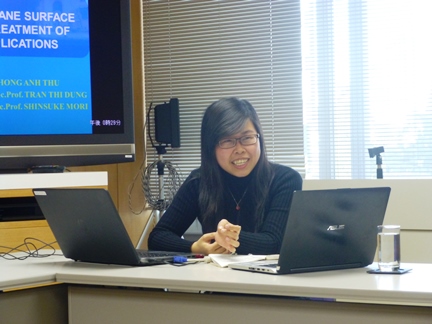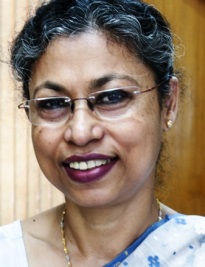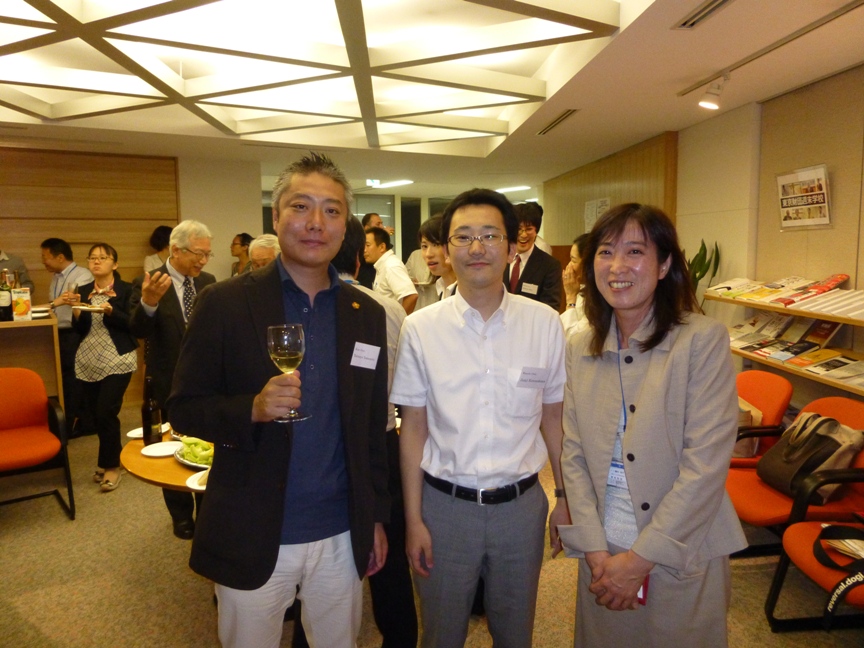Promoting the development and spread of renewable energy requires the balancing of policy tools and market inducements, notes Tokyo Foundation Research Fellow Hikaru Hiranuma, who participated in an SLI forum on climate change at the University of North Carolina at Greensboro as an expert from Japan. The March 22–24 forum was organized by University of Oregon Sylff fellow Corey Johnson and consisted of a closed session among international experts and a public symposium. Johnson is currently associate professor and Head of the Geography Department at the University of North Carolina at Greensboro.
* * *

A panel discussion on “Environmental Geopolitics in the Anthropocene” at the University of North Carolina at Greensboro.
The early ratification of the Paris Agreement has sparked renewed worldwide interest in climate change measures. It was in this context that a public symposium was held on March 23 on the issue of “Environmental Geopolitics in the Anthropocene: Ominous Horizon or Breaks in the Clouds?” at the University of North Carolina at Greensboro (UNCG).
The Paris Agreement aims to keep the rise in the global average temperature to within two degrees of preindustrial levels. Achieving this goal will require more than the fulfillment of pledges made by the signatory countries. The US administration of President Donald Trump, though, has taken a skeptical position on climate change since taking office in January 2017, and the world’s second-biggest carbon dioxide emitter seems to be shifting away from its previous commitments, putting the future of climate change countermeasures in doubt.
At the symposium, experts in such fields as environmental policy, energy, and national security came together to discuss the challenges ahead from the perspective of environmental geopolitics. This report summarizes some of the main points of interest that were raised during the discussions.
Stakeholders in Climate Change Issues
Various aspects of climate change were examined, but one recurring theme was the importance of identifying the key stakeholders. The title of the symposium itself suggested an answer. In the proposed geological era called the Anthropocene, surely every human being has a stake in finding a solution to climate change. This will require a fundamental break with existing lifestyles.
Over the course of human history, societies have developed by increasing consumption and placing an ever-heavier burden on the environment. There is a need to shift to a more sustainable model that will not place the same heavy burden on the natural environment. All of us living in the Anthropocene must first acknowledge that we ourselves are the ones who have brought about climate change and face up to the problems we have caused. Among the primary stakeholders, then, are the governments of the world that will need to enact and carry out concrete policy measures based on this shared awareness. One example of such action was the Paris Agreement, which came into force following ratification by countries around the world. Since trends and developments among the countries responsible for implementing concrete policies will have a direct impact on climate change, shifting attitudes in the United States have given rise to a sense of crisis and uncertainty regarding future climate measures.
The Influence of Major Powers
Given that countries are important stakeholders in the effort to address climate change, panelists from the United States, Canada, the Netherlands, and Japan agreed that relations between states are also extremely important—particularly those between such major emitters as China, Russia, and the United States. The United States and China alone are responsible for more than 40% of global emissions, and cooperation between them will be essential in any attempt to reduce total global emissions. A shift in US climate policy would have a huge impact on global efforts to address climate change and may require commensurate efforts by China to compensate for the change in US trajectory. Tensions between the two countries over foreign policy and national security could easily stymie negotiations on climate change, however, and the symposium served as a reminder that progress on climate change is intimately connected with trends in international relations among the major powers.
Regional Stakeholders
Other important stakeholders mentioned at the symposium included regional communities and other groups subject to common climate challenges, such as flooding and drought. Speakers suggested that such stakeholders cooperate with one another to address their concerns and to broadly share their experiences and preventive measures. Even as national policy in the United States undergoes a shift, many state governments are continuing to pursue their own measures to cope with climate change. These regional stakeholders (and others not affected by national policy) are expected to play an increasingly important role in climate change discussions in the future.
Policy and Market Receptivity
Another important point raised at the UNCG symposium was the balance between policy and the market in tackling climate change, such as in promoting the development and spread of renewable energy. One speaker mentioned that North Carolina has the second highest rate of solar power generation in the United States, a result of both market preferences and local legislative incentives known as the Renewable Portfolio Standard. When seeking to encourage private initiatives to address climate change, therefore, it is important to bear in mind that policy can crucially affect the receptivity of the market. The symposium offered important insights into how the relationship between policy and the market can have a large bearing on the effectiveness of concrete measures to address climate change.
Conclusion
The symposium was very timely, given the growing awareness of the Anthropocene concept and the shifting policies of the US administration. There is a tendency for climate change discussions to focus on isolated themes, such as energy mix, resource prices, and the policies of individual countries. But the UNCG symposium embraced a comprehensive perspective, viewing climate change through a broader temporal framework and the full range of the stakeholders involved, leading to many innovative suggestions for the future. Measures to address global climate change have only just begun, and it is important to maintain a broad perspective in identifying the best countermeasures through forums like the UNCG symposium. The stage where policy alone can induce market initiatives through reductions in the cost of renewable energy is drawing to an end, and there is a clear need to consider alternative approaches. It is to be hoped that this symposium will spawn may others like it to deepen future debate on climate change.


























































